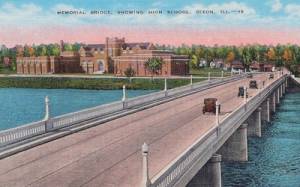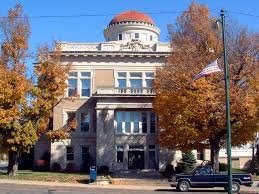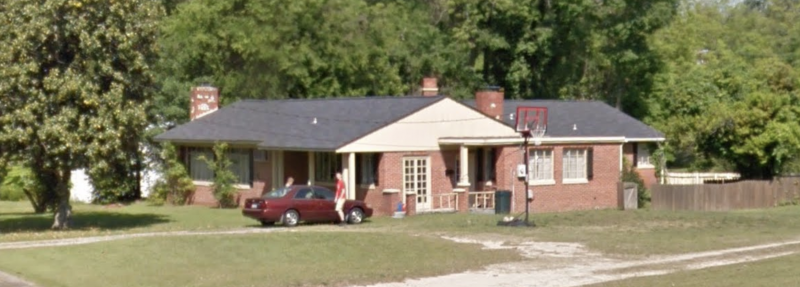The Iowa flood of 2008 was one of the most devastating events in recent Iowan history. The Iowa River and its tributaries flooded, causing an estimated $6 billion in damage. The second-largest city in the state, Cedar Rapids, bore the brunt of the flooding. Water completely inundated its civic center adjacent to its downtown–Mays Island, a half-mile long island in the middle of the Cedar River next to downtown. The image of this architectural, planning, and municipal oddity submerged in cold, muddy waters beside a flooded downtown is the most striking by far from the whole flooding event. In its center, on the top of the flooded island…yep…right there! That’s a Joseph Royer building. Linn County Courthouse, underwater.
For the uninitiated, Joseph Royer is possibly the most famous architect to come out of Champaign-Urbana. Homegrown, born in 1873, Urbana High School graduate, U of I class of 1895. His architecture is everywhere in C-U, from the Illinois Traction Building in downtown Champaign to the 1914 rebuilding of Urbana High School. He also designed the Urbana Landmark Hotel, Urbana Free Library, countless (actually countless, there’s no official record of how many exactly; many were destroyed, some don’t have a record of an architect) single-family homes in West Urbana. His former residence at 801 W. Oregon with an “elf’s cottage” for his mother in law is an absolute beauty and the Urbana Free Library has been meticulously restored and preserved, while others, like the Zeta Tau Alpha House at Vermont and Lincoln, are left to deteriorate.
 Joseph Royer did, in fact, expand his portfolio by undertaking other projects outside Chambana. In Northern Illinois, he designed Dixon High School, an imposing structure above the banks of the Rock River. A young Ronald Reagan would have seen the building near its completion by the time he graduated in 1928, the school opened one year later. Chicago Heights’ Bloom High School boasts Royer’s only project in the Chicagoland area.
Joseph Royer did, in fact, expand his portfolio by undertaking other projects outside Chambana. In Northern Illinois, he designed Dixon High School, an imposing structure above the banks of the Rock River. A young Ronald Reagan would have seen the building near its completion by the time he graduated in 1928, the school opened one year later. Chicago Heights’ Bloom High School boasts Royer’s only project in the Chicagoland area.
 Aside from residential projects, Royer was prolific in government buildings. He designed the Grundy, Piatt, and Clay County Courthouses in Illinois, the Warren County Courthouse in Indiana, and Linn County in Cedar Rapids, Iowa, by far his most significant courthouse. The courthouse in Cedar Rapids included an annex that was once an on-site jail, but it no longer functions as that. Linn County’s courthouse sustained considerable flood damage, but it was all fixed, renovated, and modernized in 2014. This is Mr. Royer’s only project currently waging a war against nature, but it looks like it will have the upper hand for the foreseeable future.
Aside from residential projects, Royer was prolific in government buildings. He designed the Grundy, Piatt, and Clay County Courthouses in Illinois, the Warren County Courthouse in Indiana, and Linn County in Cedar Rapids, Iowa, by far his most significant courthouse. The courthouse in Cedar Rapids included an annex that was once an on-site jail, but it no longer functions as that. Linn County’s courthouse sustained considerable flood damage, but it was all fixed, renovated, and modernized in 2014. This is Mr. Royer’s only project currently waging a war against nature, but it looks like it will have the upper hand for the foreseeable future.
Though most of his works were based in Champaign-Urbana, his two courthouse projects were some of the rare instances he ever designed outside of his own state. He never really got too far past the state line before returning to good ol’ C-U. Except one time.
Rockingham, North Carolina lies along the Great Pee Dee River at the south-central part of the state. It’s a small town hugging the South Carolina border, distinctly southern. I don’t know how Royer got here or why Jay Helms, the future owner of the house, hired him. I don’t know why he traveled all the way to Central Carolina to design a private residence. It’s part of Rockingham’s National Historic District, so I assumed it’s a grandiose, antebellum residence, maybe incorporating some of Royer’s traditional arts-and-crafts elements. I look to Google StreetView to see it and struggle to find it. That’s because it looks nothing like a Royer house. It’s a ranch house, straight out of some 1950’s car commercial. I couldn’t believe the mastermind behind the Urbana Free Library, Linn County Courthouse, Urbana’s charming homes, and UHS could design something so bland. Why did he go all the way there to design something so small and seemingly forgettable? Do Rockingham residents realize what they have occupying roughly an acre of land on their east side? If so, do they think they’ve been shortchanged?

The University of Illinois has hosted some of the world’s most influential architects. Jeanne Gang designed the Aqua Tower in Chicago, the tallest building ever designed by a woman. James Pawlikowski was a lead designer in the Burj Khalifa, the world’s current tallest building. Max Abramowitz designed both the State Farm Center and the world-famous Lincoln Center in New York. Much of Chicago’s skyline comes from the minds that once graced the University, but Mr. Royer is different, he never up and left C-U. Sure, he took a few commissions elsewhere, but he was a C-U architect through and through. Maybe he saw too much opportunity here to leave, maybe he knew that staying here was a safe career bet, maybe he was afraid of getting homesick. We can’t be certain, just happy that he stuck around.
Explore his works in Urbana here: http://www.urbanaillinois.us/sites/default/files/attachments/royer-district-brochure.pdf
Images: Cedar Rapids from Wikimedia Commons, Dixon High School from City of Dixon, Warren County Courthouse from Wikimedia Commons, and the Rockingham, NC house from Google Streetview








